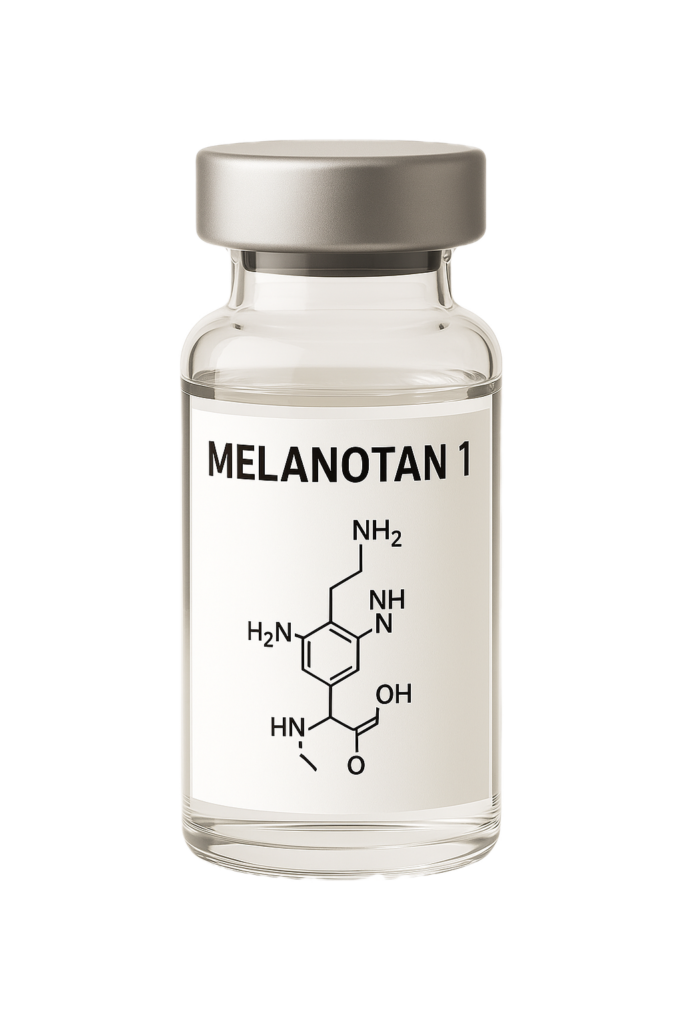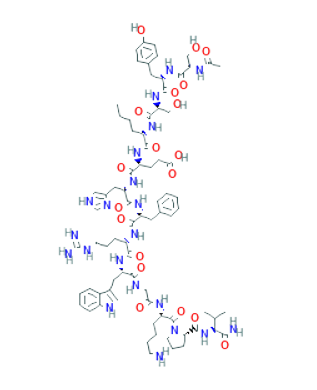Melanotan 1
Management of photosensitivity disorders like EPP
Potential photoprotection against UV-induced skin damage
Melanotan 1 (MT-1) is a synthetic analog of the naturally occurring hormone alpha-melanocyte-stimulating hormone (α-MSH). It is primarily researched for its ability to stimulate melanin production, leading to increased skin pigmentation. MT-1 has been studied for potential applications in reducing UV-induced skin damage and managing certain photosensitivity disorders.
Mechanism of action
MT-1 binds to melanocortin 1 receptors (MC1R) on melanocytes, activating the production of eumelanin, the dark pigment in the skin. This process enhances the skin’s natural defense against ultraviolet radiation by increasing pigmentation and potentially reducing oxidative stress. MT-1 is designed to resist enzymatic degradation, offering a longer duration of action compared to natural α-MSH.
Notable Studies
Clinical trials have explored MT-1’s efficacy in preventing phototoxicity in individuals with erythropoietic protoporphyria (EPP), a condition causing extreme sensitivity to sunlight.
Research indicates that MT-1 can induce skin tanning with minimal UV exposure, suggesting potential for reducing sun-related skin damage.
Risk Associated
While MT-1 has shown promise in clinical settings, potential side effects include:
Nausea
Facial flushing
Fatigue
It’s important to note that unregulated use, especially through non-medical channels like nasal sprays, has been linked to severe adverse effects, including allergic reactions and potential links to melanoma.
Dosage
In clinical research, MT-1 has been administered subcutaneously at doses ranging from 0.08 mg/kg to 0.16 mg/kg daily for periods up to 10 days.
External link


Melanotan 1
Management of photosensitivity disorders like EPP
Potential photoprotection against UV-induced skin damage
Mechanism of action
MT-1 binds to melanocortin 1 receptors (MC1R) on melanocytes, activating the production of eumelanin, the dark pigment in the skin. This process enhances the skin’s natural defense against ultraviolet radiation by increasing pigmentation and potentially reducing oxidative stress. MT-1 is designed to resist enzymatic degradation, offering a longer duration of action compared to natural α-MSH.
Risk
Associated
While MT-1 has shown promise in clinical settings, potential side effects include:
Nausea
Facial flushing
Fatigue
It’s important to note that unregulated use, especially through non-medical channels like nasal sprays, has been linked to severe adverse effects, including allergic reactions and potential links to melanoma.
Notable Studies
Clinical trials have explored MT-1’s efficacy in preventing phototoxicity in individuals with erythropoietic protoporphyria (EPP), a condition causing extreme sensitivity to sunlight.
Research indicates that MT-1 can induce skin tanning with minimal UV exposure, suggesting potential for reducing sun-related skin damage.
Dosage
In clinical research, MT-1 has been administered subcutaneously at doses ranging from 0.08 mg/kg to 0.16 mg/kg daily for periods up to 10 days.
External link
Melanotan 1
Management of photosensitivity disorders like EPP
Potential photoprotection against UV-induced skin damage
Mechanism of action
MT-1 binds to melanocortin 1 receptors (MC1R) on melanocytes, activating the production of eumelanin, the dark pigment in the skin. This process enhances the skin’s natural defense against ultraviolet radiation by increasing pigmentation and potentially reducing oxidative stress. MT-1 is designed to resist enzymatic degradation, offering a longer duration of action compared to natural α-MSH.

Risk
Associated
While MT-1 has shown promise in clinical settings, potential side effects include:
Nausea
Facial flushing
Fatigue
It’s important to note that unregulated use, especially through non-medical channels like nasal sprays, has been linked to severe adverse effects, including allergic reactions and potential links to melanoma.
Notable Studies
Clinical trials have explored MT-1’s efficacy in preventing phototoxicity in individuals with erythropoietic protoporphyria (EPP), a condition causing extreme sensitivity to sunlight.
Research indicates that MT-1 can induce skin tanning with minimal UV exposure, suggesting potential for reducing sun-related skin damage.
Dosage
In clinical research, MT-1 has been administered subcutaneously at doses ranging from 0.08 mg/kg to 0.16 mg/kg daily for periods up to 10 days.
External link
-
Melanotan 1: mechanisms of action, clinical applications and safety. ChemicalBook.
-
Effects of a superpotent melanotropic peptide in combination with ultraviolet B radiation on tanning of the skin in humans. PubMed.
-
Melanotan 1 (MT1) 10mg. Peptide Sciences.
-
Skin pigmentation and pharmacokinetics of melanotan-I in humans. University of Arizona.
-
I have permanent skin damage from using tanning nasal spray twice – it made me dizzy & nauseous too, says former Miss GB. The Sun.